Blog
How to Create a Shareable Job Aid
The number one most effective form of shareable job aid I have seen is the humble checklist. It’s a simple but powerful tool used from kindergarten classrooms to nuclear launch sites. And in a world of increasingly remote, asynchronous work, these types of job aids will be invaluable.
Yet, as simple as they may be, good checklists can be difficult to make. Here is a step-by-step process to follow the next time you need to create a checklist, whether you are training a colleague or improving your own workflow.
Step one: Break things down and write them out
Start with what you know. Break down the task or project into a list of step-by-step instructions, incorporating any resources or job aids you currently use. Then, take each step further by breaking it down into a series of concrete actions. Get as granular as you possibly can—maybe even go overboard a little. It will always be easier to remove unnecessary steps from your checklist than to add in necessary steps later.
Step two: Follow your instructions as if you were a newbie
Once you have a detailed, step-by-step outline, try using it as though you were totally new to the task or project. Follow the instructions exactly as you have written them: avoid subconsciously filling in any gaps with your own expertise. Don’t assume that anything goes without saying, especially if the task or project is especially technical or complex. As you follow your instructions, make corrections and additions as you go. Don’t make the mistake of assuming you will remember to make necessary corrections or additions later!
Step three: Make final edits
Follow your updated and improved instructions one final time. Make any further corrections or additions as necessary. Include as many details as possible for, and between, each step.
Step four: Turn it into a checklist
Now it’s time to take your instructions and translate them into a checklist format. Checklists are primarily tools of mindfulness: they slow us down and focus us on the present actions under our control. Consider whether the checklist will be more helpful if it is phrased in past or present tense. Who will be using the checklist? What information do they need to know? How much of the checklist can be understood at-a-glance?
Step five: Get outside input
Ask someone to try using your checklist and see if it works for them. Get their feedback about what was clear, what was unclear, and why it was clear or unclear. Ask about any questions they had that weren’t answered by the checklist. Solicit other suggestions, thoughts, or improvements you may not have considered. Incorporate their input and then repeat the process with another tester.
Step six: Use your checklist!
Don’t simply create your checklist for others and then abandon it. Use the checklist in your own work going forward and treat it as a living document. Make clarifying notes, additions, and improvements as the work naturally changes over time. Remember, checklists are tools of mindfulness. Use them as ways to tune in to the work you already do and identify opportunities for growth and improvement.
Establish a system for saving drafts, templates, and examples of your work
Of course, checklists are just one type of shareable job aid. Sharing examples of previous work is another useful way to help someone jumpstart a new task or project. This can be anything from final products to drafts, sketches, templates, or even videos. Get creative! Being known as the go-to person for these types of job aids and resources is a surefire way of becoming indispensable.
Improve how you collaborate with our online training course
This post is based on a lesson from our newest RainmakerLearning online course: Back-To-Fundamentals Collaboration: The Art of Being Indispensable at Work. Get this lesson, plus nearly three more hours of content for only $50! Enroll at RainmakerLearning.com.
